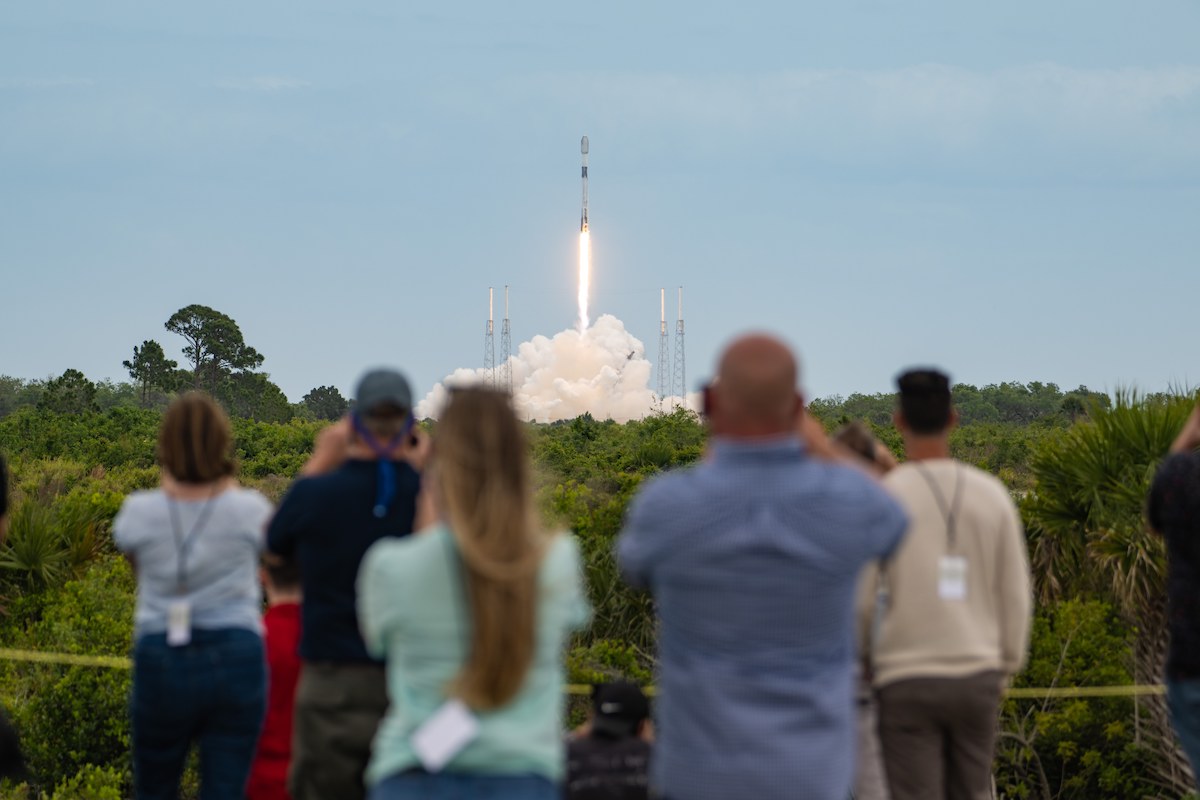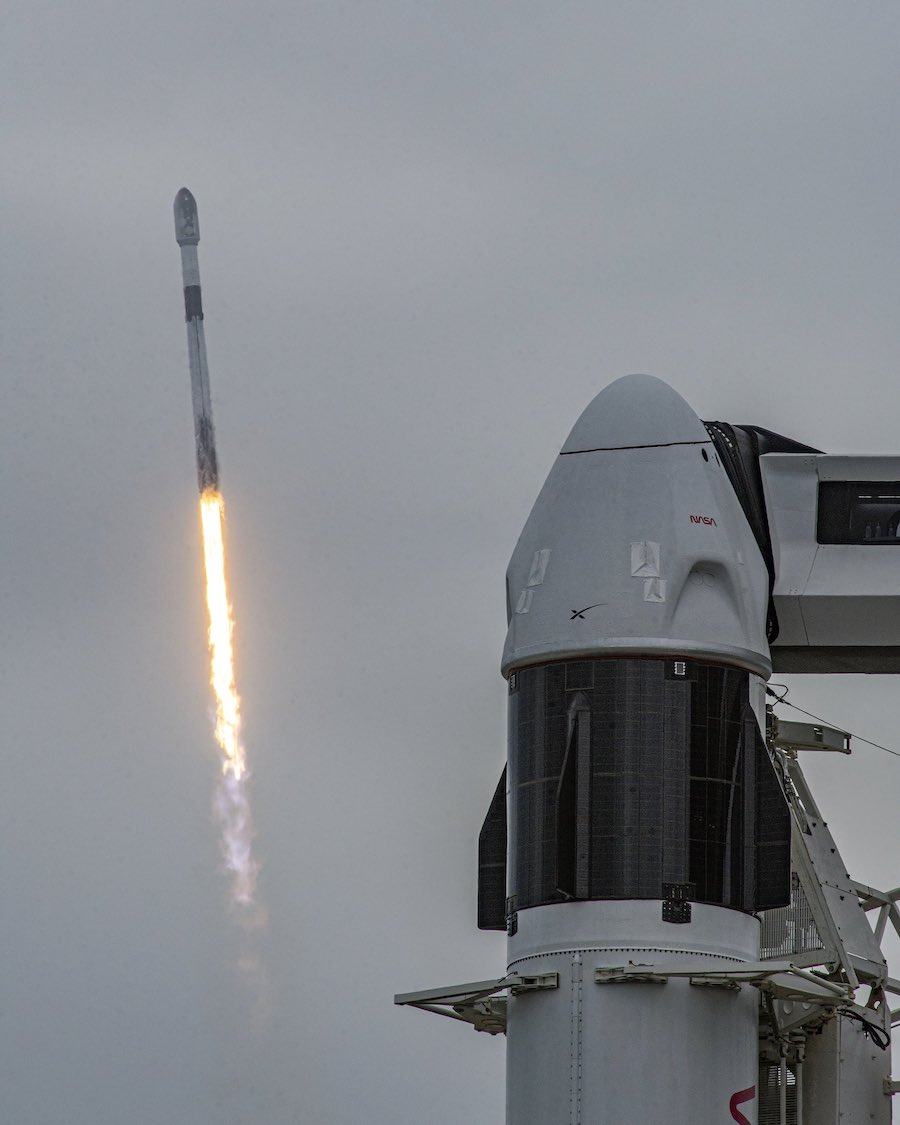Space News & Blog Articles
SpaceX deploys more Starlink satellites, aims for higher launch cadence
 A Falcon 9 rocket lifts off Thursday with 53 more Starlink internet satellites. Credit: Michael Cain / Spaceflight Now / Coldlife Photography
A Falcon 9 rocket lifts off Thursday with 53 more Starlink internet satellites. Credit: Michael Cain / Spaceflight Now / Coldlife Photography
SpaceX launched 53 more Starlink satellites Thursday from Cape Canaveral, growing the company’s commercial internet network while ground teams seek to increase the already-blistering pace of Falcon 9 rocket missions.
A Falcon 9 took off at 1:51:40 p.m. EDT (1751:40 GMT) Thursday from pad 40 at Cape Canaveral Space Force Station in Florida to begin SpaceX’s 42nd launch dedicated to deploying satellites for the Starlink network.
SpaceX’s launch team delayed the liftoff from a launch opportunity Thursday morning due to high winds at the Florida spaceport. Conditions improved sufficiently to permit launch of the Falcon 9 a couple of hours later.
Thursday’s mission, named Starlink 4-14, was SpaceX’s 15th Falcon 9 launch of the year, and the 149th flight of a Falcon 9 rocket since the workhorse launcher debuted on June 4, 2010.
Following a familiar profile for launch-watchers, the Falcon 9 headed northeast from Cape Canaveral Space Force Station, soaring through clouds and climbing into the upper atmosphere downrange over the Atlantic Ocean. The rocket’s nine Merlin 1D engines produced about 1.7 million pounds of thrust at full power.
The engines switched off and the booster separated from the second stage of the Falcon 9 about two-and-a-half minutes after liftoff. The second stage’s single Merlin engine fired to push the 53 Starlink payloads into a preliminary parking orbit, while the booster configured itself for a scorching-hot plunge back into the atmosphere.
The first stage extended four titanium hypersonic grid fins to help steer itself through the rarefied upper atmosphere. An entry burn using three of the first stage engines, then a final braking burn using a single engine, slowed the rocket for landing on the football field-sized drone ship “Just Read the Instructions.”
SpaceX’s Falcon 9 first stage successfully landed on the drone ship in the Atlantic Ocean.
This booster has now launched 587 satellites on 12 missions.https://t.co/1EpUA64wr7 pic.twitter.com/HpfK3WTas7
— Spaceflight Now (@SpaceflightNow) April 21, 2022
The landing platform was positioned in the Atlantic Ocean a few hundred miles east of Charleston, South Carolina. After the rocket landing, the drone ship will return the 15-story-tall booster to Cape Canaveral for refurbishment.
The booster that flew on Thursday’s mission made its 12th flight to space, tying a record number of flights for SpaceX’s reusable rocket fleet. The rocket — tail number B1060 — first launched June 30, 2020, with a U.S. military GPS navigation satellite.
Most recently, the booster launched March 3 with a previous batch of Starlink internet satellites.
The Falcon 9’s upper stage engine shut down nearly nine minutes into the mission, moments after the landing of the first stage downrange in the Atlantic Ocean.
After coasting across the North Atlantic, over Europe and the Middle East, then across the Indian Ocean, the upper stage reignited its engine for a brief one-second firing to maneuver the 53 Starlink satellites into the proper orbit for separation.
The Falcon 9’s guidance computer aimed to release the flat-panel satellites just shy of one hour after launch in an orbit between 189 miles and 197 miles (304 by 318 kilmeters) above Earth, with an inclination of 53.2 degrees to the equator.
SpaceX confirmed the upper stage deployed the 53 satellites, each a bit more than a quarter-ton in mass, into the expected orbit.
The Starlink satellites will extend solar arrays and use on-board ion thrusters to reach their operational orbit at an altitude of 335 miles (540 kilometers), where they will enter commercial service for SpaceX.
With Thursday’s mission, SpaceX has launched 2,388 Starlink satellites to date. Around 2,121 of those satellites are still in orbit and appear to be working, and the rest have either failed or fallen out of orbit, according to a list maintained by Jonathan McDowell, an astrophysicist who closely tracks spaceflight activity.
That’s nearly five times the number of active satellites currently flying in the second-largest fleet of spacecraft — the internet constellation owned by Starlink rival OneWeb. In third place is Planet, which operates a fleet of more than 200 small Earth-imaging satellites.
SpaceX is in the midst of launching around 4,400 Starlink satellites into five orbital “shells” more than 300 miles above Earth. The shells are positioned at different inclinations, and SpaceX completed launches of the first of the five Starlink groups last May.
Ultimately, SpaceX intends to launch as many as 42,000 internet satellites. The final figure hinges on market demand for the Starlink service, which offers high-speed, low-latency connectivity.
SpaceX says the service is best suited for customers in remote, hard-to-reach areas, such as rural communities, isolated homes, islands, and ships. Customers can sign up for Starlink service online by paying a reservation fee and paying $599 for an antenna and modem. SpaceX charges $110 per month for consumer-grade Starlink service.
SpaceX has partnered with the U.S. military to demonstrate Starlink connectivity to airplanes. Delta Air Lines has also conducted “exploratory” tests of the Starlink system for possible future use on passenger aircraft, according to the Wall Street Journal.
Hours after the Starlink launch Thursday, the air carrier JSX announced it will outfit 100 of its private jets to use SpaceX’s internet service for in-flight WiFi. The first Starlink-equipped JSX aircraft should be flying later this year, the company said.
“High-speed, low-latency internet is critical in our modern age, and during air travel is no exception,” said Jonathan Hofeller, SpaceX’s vice president of Starlink commercial sales, in a press release. “With Starlink, we’re able to provide an internet experience similar to or better than what passengers experience at home. We are creating a future that when all customers walk on to the plane, the internet just works — no hassles, no logins. By being the first air carrier to adopt Starlink, JSX is setting this new standard for air travel.”
 A Falcon 9 rocket launches 53 more Starlink satellites Thursday, while another Falcon 9 and SpaceX’s Dragon Freedom spacecraft stand a few miles away on a different launch pad. Credit: SpaceX
A Falcon 9 rocket launches 53 more Starlink satellites Thursday, while another Falcon 9 and SpaceX’s Dragon Freedom spacecraft stand a few miles away on a different launch pad. Credit: SpaceX
The launch of the Starlink 4-14 mission will be followed by the flight of another Falcon 9 rocket currently standing on pad 39A at NASA’s Kennedy Space Center, a few miles north of the pad 40 at Cape Canaveral Space Force Station.
The launch from pad 39A will carry four astronauts into orbit aboard SpaceX’s Dragon Freedom spacecraft on NASA’s Crew-4 mission to the International Space Station. The launch is scheduled for no earlier than next Tuesday, April 26, three days later than previously planned due to weather delays that have pushed back the return of another SpaceX Dragon crew capsule from the space station.
SpaceX’s next Starlink mission is scheduled for launch no earlier than next Friday, April 29, also from pad 40 at Cape Canaveral Space Force Station. That launch will use the same drone ship employed on Thursday’s Starlink 4-14 mission. SpaceX’s drone ship team will attempt an eight-day turnaround to return one Falcon 9 booster to port, and then re-deploy for the next rocket landing.
Elon Musk, SpaceX’s founder and CEO, said the company is making refurbishment and performance enhancements to improve the Falcon 9 and Falcon Heavy launch cadence.
“SpaceX Falcon team making great progress!” Musk tweeted earlier this week. “Aiming for 5 day launch cadence with many performance & refurb improvements.”
Musk said last month SpaceX wants to launch as many as 60 Falcon rocket missions this year.
Two more Falcon 9 rockets are scheduled to launch on Starlink missions May 8, followed as many as three additional Falcon 9 launches later next month from pads in Florida and California.
This email address is being protected from spambots. You need JavaScript enabled to view it. the author.
Follow Stephen Clark on Twitter: @StephenClark1.
When you subscribe to the SpaceZE News Feed, we will send you an e-mail when there are new updates on the site so you wouldn't miss them.

